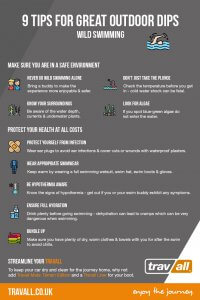Wild swimming has seen a surge in popularity in the UK in recent years. With many of us leading fairly sedentary lives in urban environments, wild swimming offers the opportunity to get fit and reconnect with nature at the same time. There are many things to consider when going wild swimming and these will change depending on the season and sometimes the tide. So we thought we’d share our top 10 tips for wild swimming so you can enjoy the sport safely:
1. Never go wild swimming alone. Make sure you have a buddy with you. It’ll not only make the experience more enjoyable, but will make sure you can look out for each other’s welfare.
2. Don’t just take the plunge. Swimming outdoors can be seriously cold even during the warmer months of the year, so it is essential that you are aware of the temperature of the water. Ease yourself into the water gradually to avoid cold water shock, which can prove fatal.
3. Know your surroundings. Be aware of the depth of the water and of any currents and underwater plants such as reeds.
4. Wear appropriate swimwear. Wearing a full swimming wetsuit gives some protection from the cold. A swim hat in neoprene is also advised as are swim boots and gloves – the extremities feel the cold more.
5. Protect yourself from infection. Wear ear plugs to avoid ear infections. Cover any cuts or wounds with waterproof plasters.
6. Look for algae. If you spot blue-green algae (more common in warmer weather conditions) don’t enter the water. Blue-green algae is hazardous to your health.
7. Be hypothermia aware. Know the signs of hypothermia, so you can spot this in you or your swimming companion. Exit the water if either of you exhibit symptoms.
8. Ensure full hydration. Drink plenty of fluids prior to swimming. Dehydration can lead to cramps, which can be dangerous when swimming.
9. Bundle up. Make sure you have plenty of dry warm clothing and towels with you for after the swim to avoid chills.
10. Protect your ride. Add rubber car mats and a rubber boot liner to keep your car clean and dry on the journey home.


This blog post gives tips on how to have an enjoyable wild swimming experience and offers a handy infographic too.
Adding Travall vehicle-specific rubber mats and a boot liner are great ways to protect your car from wet gear.
Other posts that might interest you:
Stand up paddle boarding with dogs: why winter is the best time to start